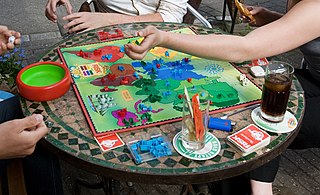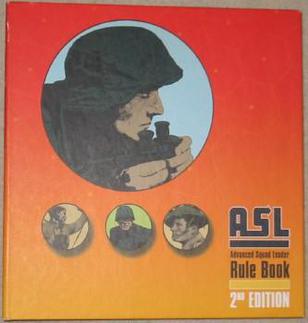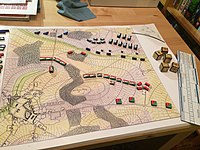
A wargame is a strategy game in which two or more players command opposing armed forces in a simulation of some military operation. Wargaming may be played for recreation, to train military officers in the art of strategic thinking, or to study the nature of potential conflicts. Many wargames re-create specific historic battles, and can cover either whole wars, or any campaigns, battles, or lower-level engagements within them. Many simulate land combat, but there are wargames for naval and air combat, as well.

Risk is a strategy board game of diplomacy, conflict and conquest for two to six players. The standard version is played on a board depicting a political map of the world, divided into 42 territories, which are grouped into six continents. Turns rotate among players who control armies of playing pieces with which they attempt to capture territories from other players, with results determined by dice rolls. Players may form and dissolve alliances during the course of the game. The goal of the game is to occupy every territory on the board and, in doing so, eliminate the other players. The game can be lengthy, requiring several hours to multiple days to finish. European versions are structured so that each player has a limited "secret mission" objective that shortens the game.

Avalon Hill Games Inc. is a game company that publishes wargames and strategic board games. It has also published miniature wargaming rules, role-playing games and sports simulations. It is a subsidiary of Hasbro, and operates under the company's "Hasbro Gaming" division.

Richthofen's War, subtitled "The Air War 1916–1918", is a board wargame published by Avalon Hill in 1973 that simulates aerial combat during World War I.

Advanced Squad Leader (ASL) is a tactical-level board wargame, originally marketed by Avalon Hill Games, that simulates actions of squad sized units in World War II. It is a detailed game system for two or more players. Components include the ASL Rulebook and various games called modules. ASL modules provide the standard equipment for playing ASL, including geomorphic mapboards and counters. The mapboards are divided into hexagons to regulate fire and movement, and depict generic terrain that can represent different historical locations. The counters are cardboard pieces that depict squads of soldiers, crews, individual leaders, support weapons, heavy weapons, and vehicles.

Memoir '44 is a light wargame or war-themed strategy board game for two players. It was created by Richard Borg and published in 2004 by Days of Wonder. Illustration done by Julien Delval and Cyrille Daujean. The game can be played with up to six players if played in teams and up to eight players in the "Overlord" scenarios. However, "Overlord" requires two copies of the game. It received the 2004 International Gamers Award for General Strategy, 2-Player category and The Wargamer 2004 Award for Excellence. The game is published in English and French by Days of Wonder.

Squad Leader is a tactical level board war game originally published by Avalon Hill in 1977. It was designed by John Hill and simulates on infantry combat in Europe during World War II. One of the most complex war games of its time, Squad Leader is the natural extension of the trend towards greater realism initiated by several earlier games, including Avalon Hill's own PanzerBlitz and Panzer Leader. Those two earlier games were slightly larger in scope, with counters representing platoons and map hexes measuring 250 metres across, compared to Squad Leader's 40 meter hexes and squad sized units.

The Russian Campaign is a strategic board wargame published by Jedko Games in 1974 that simulates combat on the Eastern Front during World War II. Avalon Hill later bought the game and produced several editions.
Battle Cry is a board wargame based on the American Civil War, designed by Richard Borg and published by Avalon Hill in 2000.

Battle of the Bulge is a board wargame published by Avalon Hill (AH) in 1965 that simulates the World War II battle of the same name. General Anthony McAuliffe (ret.), who had been commanding officer at Bastogne during the Battle of the Bulge, was a consultant during the game's development. The game proved popular and sold more than 120,000 copies, but was dogged by criticisms of historical inaccuracies, and was finally replaced by a completely new edition in 1981. A third edition in 1991 was released as part of the Smithsonian American History Series.
Modules for the game Advanced Squad Leader (ASL) contains all the equipment needed to actually play the game. There are 14 official so-called "core" modules that contain the essential components for a complete order of battle of all major nationalities to participate in the Second World War. Ownership of all core modules is not a prerequisite to playing the game, and as few as one module can be used. In addition to core modules, other products are also available and may be loosely referred to as "modules", or in the more specific terms as Deluxe ASL Modules and Historical ASL Modules. These required previous ownership of some of the core modules in varying combinations, or at least the components of them.

Source of the Nile is a board game published by Discovery Games in 1977 that simulates the exploration of Africa in the 19th century. A second edition of the game was published by Avalon Hill in 1979.
BattleLore is a strategy board wargame for two players, created by Richard Borg and initially published by Days of Wonder in 2006. The game is based on the same mechanics as Battle Cry, Memoir '44 and Commands & Colors: Ancients, but has a fantasy and medieval theme.

Tobruk, subtitled "Tank Battles in North Africa 1942", is a board wargame published by Avalon Hill in 1975 that simulates tank combat in North Africa during World War II.

Commands & Colors: Ancients is a board wargame designed by Richard Borg, Pat Kurivial, and Roy Grider, and published by GMT Games in 2006. It is based on Borg's Commands & Colors system using some elements similar to his other games such as Commands & Colours: Napoleonics, The Great War, Memoir '44 and Battle Cry designed to simulate the "fog of war" and uncertainty encountered on real battlefields.

A board wargame is a wargame with a set playing surface or board, as opposed to being played on a computer or in a more free-form playing area as in miniatures games. The modern, commercial wargaming hobby developed in 1954 following the publication and commercial success of Tactics. The board wargaming hobby continues to enjoy a sizeable following, with a number of game publishers and gaming conventions dedicated to the hobby both in the English-speaking world and further afield.

The Dungeons & Dragons Basic Set is a set of rulebooks for the Dungeons & Dragons (D&D) fantasy role-playing game. First published in 1977, it saw a handful of revisions and reprintings. The first edition was written by J. Eric Holmes based on Gary Gygax and Dave Arneson's original work. Later editions were edited by Tom Moldvay, Frank Mentzer, Troy Denning, and Doug Stewart.

RoboRally is a board game for 2–8 players designed by Richard Garfield and published by Wizards of the Coast (WotC) in 1994. Various expansions and revisions have been published by both WotC and by Avalon Hill.

Air Force is a board wargame published by Battleline Publications in 1976, and subsequently re-released by Avalon Hill in 1977, that simulates air combat during World War II. Several expansions for the game were also published.

Heroscape is an expandable turn-based miniature wargaming system originally manufactured by Hasbro subsidiaries from 2004 until its discontinuation in November 2010. Geared towards younger players, the game is played using pre-painted miniature figures on a board made from interlocking hexagonal tiles, allowing for the construction of an interchangeable and variable 3D landscape. This system and the relatively high production quality of the game materials have been lauded by fans even years after the game was discontinued.


















